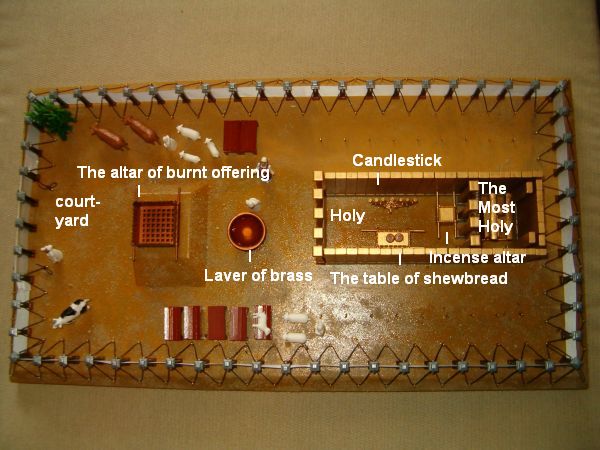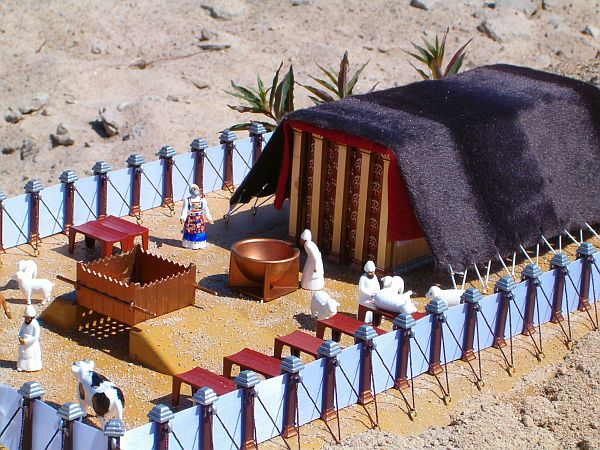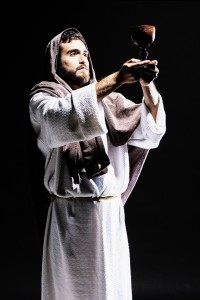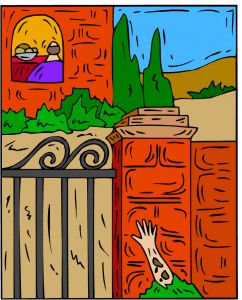In this video, Natan begins to decode the mysteries of the Tabernacle of Moses and shows how YHVH’s plan of salvation and the gospel message of Yeshua are encrypted within the tabernacle’s ceremonies and furnishings. The focus of this teaching is on the outer courtyard. A free study guide is available at http://hoshanarabbah.org/pdfs/tabernacle.pdf. Check out Natan’s other videos on the Tabernacle of Moses.
Tag Archives: Yeshua
The Steps of Redemption Within the Tabernacle
First Step of Eight: One is in a state of separation from his Creator because of sin. One sees the good news, the light of truth, the message of the cross, the multi-colored door and the luminescent walls of the tabernacle. As one takes his first steps to become separated or set-apart from the confusion, darkness, chaos, emptiness, lostness and death of the world one must first encounter the altar of the red heifer located outside the tabernacle (in later years on the Mount of Olives opposite the temple, Mishnah Parah 1:1ff). There the red heifer was slaughtered and burned and its ashes were used as a sin offering to bring about purification for uncleanness (Num 19:1ff). Yeshua was likewise crucified outside of the camp of Israel and the gates of Jerusalem (Heb 13:10–13). This altar represents the work of Yeshua at the cross. One cannot enter the tabernacle until one has been redeemed and purified by the blood of Yeshua. Even the Israelites killed the Passover lamb outside their homes on the afternoon of the fourteenth of the month of Abib The blood was then smeared on the doors of their homes. Once they entered the blood-smeared doors and were inside their homes they were safe from the death angel who simply passed over them. Likewise, when we enter through the gates of the tabernacle (which are crimson in color, as well as blue, white and purple—colors which point to the four Gospels and the four aspects of Yeshua’s mission as Redeemer) we do so saved and purified. This is the Passover (Pesach), which is the first of YHVH’s seven annual appointed times (moedim).
Second Step of Eight/First Step of Seven: Upon entering the tabernacle one immediately comes to the altar of sacrifice. After the lamb was sacrificed on the afternoon of Passover, that evening (the beginning of the fifteenth day of the first month, which was also the first day and a high Sabbath of the Feast of Unleavened Bread/Hag HaMatzot) the Continue reading
Benefits of Studying About the Tabernacle of Moses
Why Study the Tabernacle (or Temple)?
- Elohim commanded his people to study it. In Ezekiel 43:10–11, YHVH tells Ezekiel to explain to his people the layout of the temple “that they may be ashamed of their iniquities [Torahlessness]” and presumably repent or return to a spiritual relationship with him.
- Elohim commanded his people to build the tabernacle (and latter the temples, see Exod 25:8; 29:43; 1 Chron 17:11–15); therefore, it must be important, and we should study it to understand its significance. After all, one-half of the Torah and one-third of the 613 Torah commandments deal with the temple, so it behooves us to understand it’s spiritual significance.
- Elohim’s name resided in the tabernacle (and temple, Deut 12:5–6), and it’s where his place of abiding on the earth (Exod 25:8).
- Both the tabernacle and first and second temples in Jerusalem were the spiritual centers for the nation of Israel. Elohim’s manifest presence was found within these physical structures, and this phenomenon powerfully unified the 12 tribes of Israel making them feel as though they were one nation under YHVH’s divine protection and guidance (Exod 40:34–38). The temple became the focal point for all worship for the entire nation (Ps 5:7). For example, it was the place where YHVH chose to place his name and where all Israelites were to gather three times each year at YHVH’s appointed times (Deut 12:5, 11, 21; 14:23, 24; 16:2, 6,11; 26:2).
- The tabernacle (temple) was a monument to Elohim’s sovereignty. It was the place where he dwelt and where men come to commune with the Sovereign King and Creator (Exod 25:8; Pss 26:8; 27:4; 65:4; 92:13–15).
- It was a place to renew Israel’s covenant with Elohim. When the Israelites came to the temple to give their offerings, to make sacrifices and to commune with YHVH during his appointed times, they were doing so out of obedience to his covenants he had made with them. In so doing, they were renewing that covenantal relationship with him.
- The tabernacle and temples were the place where atonement for sin was made through the sacrifices that were offered there.
These points were taken from the Hebrew Roots magazine, Jan–March 2011, and was written by Dean Wheelock.
The Benefits of Studying About the Tabernacle?
- It teaches us how to properly approach a holy Elohim through turning from or repenting of sin (Ezek 14:6).
- It reveals YHVH’s plan of redemption.
- It teaches us about the priesthood of Messiah (Heb 7:26–28).
- It helps us to understand the kingdom of Elohim, which is an essential element of the gospel message (Mark 1:15–15). Yeshua will rule the earth during the Millennium from his temple in Jerusalem (Zech 14:4, 8–9, 11; Rev 20:6; Matt 6:9–10; Ezek 44:23 cp. 2 Cor 6:17).
- The tabernacle teaches us how to order our lives. Even as the morning and evening sacrifices were conducted in an orderly manner following certain protocols, this teaches us how to order our daily lives around our devotions to Elohim. The biblical feasts (the weekly and annual sabbaths) also revolved around the tabernacle, even as our lives should revolve around these feasts that help lead us into the presence of and relationship with Elohim as represented by the tabernacle.
- It helps us to recognize and avoid idolatry and all manner of abominable and worldly practices because it teaches us the importance of holiness when approaching a holy Elohim.
- It teaches us to be conscious about dwelling (living our lives as if we were) in the very presence or courtyard or throne room of Elohim.
- Everything in the tabernacle (and temple) pointed to Yeshua’s atoning death on the cross for our sins, and his work as our Great Heavenly High Priest Advocate who is presently at the right hand of the Father in heaven. It reveals to us the gospel message in an active and pictorial way. All these things are for our learning and admonition (1 Cor 10:11; Rom 15:4).
These points were taken from the Hebrew Roots magazine, Jan–March 2011, and was written by Dean Wheelock.
Major Themes of the Tabernacle/Mishkan
- Going from the profane/polluted to the kadosh/set-apart, from darkness to light, disobedience to obedience.
- Progressive separation and refinement of the individual leading to purity and perfection.
- Growing in progressive intimacy and fellowship with the Father.
- The steps of the biblical wedding ceremony; the marriage of YHVH to his people.
- The seven steps of spiritual growth and reconciliation to the Father as epitomized by the seven annual appointed times or festivals (moedim).
- The tabernacle pictures two spiritual processes going on simultaneously inside the heart man. One process is from the viewpoint of a man, from the outside of the tabernacle looking in. The other process is from the viewpoint of Elohim inside of the holy of holies looking out. From the outside of the tabernacle looking in, from man’s perspective, as he enters the tabernacle, it’s about going from a phsyical and outward state of cleanliness and holiness to an inward and spiriual of cleanliness and holiness as one approaches the holy of holies representing the Presence of YHVH Elohim. From Elohim’s perspective from the inside of the tabernacle looking outward, it’s about cleansing the man from the inside out starting with the spirit of man moving to his physical body. Indeed, when one becomes spiritually regenerated, it’s the inside of the man, or his spirit, that is first regnerated and activated. After that, the soul (the mind, will and emotions) of a man is progressively regenerated throughout his lifetime. Finally, at the resurrection of the dead, a man’s body is regenerated and glorified receiving immortality.
New Video: From Egypt to the Mountain of YHVH — The Gospel Message
In this video, we will learn how the children of Israel’s deliverance from Egypt and trek to Mount Sinai where YHVH gave them his instructions in righteousness in preparation for entering the Promised Land contains the full gospel message. It is the story of our spiritual journey, and gives us inisghts into what lies ahead for us en route to the Promised Land of our spiritual and eternal inheritance through Yeshua the Messiah.
What is the “cup of salvation?”
Psalms 116:13, Cup of Salvation [Yeshua]. This is the only place this phrase occurs in the Scriptures, and it’s prophetic significance should not to be overlooked.
The Hebrew word cup [kos] often relates to Elohim’s judgment as he pours out his wrath upon rebellious people (e.g. Jer 25:15). Yeshua encountered this cup at Gethsemane (Matt 26:39).
There is also a cup of blessing, which men can drink from if they choose to do so. This is the cup of YHVH’s blessing and forgiveness through Yeshua that he offers to men. This is the subject of this passage. Interestingly, the third cup of the Passover seder is called the cup of redemption (or salvation). This is the communion cup that Yeshua offered his disciples at the last supper. It was this cup that represented the blood of the Savior and that was taken along with the unleavened bread representing Yeshua’s body. This same cup of salvation pictures the saint’s blessed relationship with Yeshua, and is a picture of the new covenant, which, in reality, is the saint’s entering into a state of marriage betrothal to Yeshua their heavenly Bridegroom.
The Parable of Lazarus and the Rich Man Explained
Luke 16:19–31, The Parable of Lazarus and the Rich Man. This, and the other parables of Yeshua, are known as aggadah (also haggadah)—a very popular literary style during the second temple period whereby Jewish sages taught moralistic principles to their pupils. It was similar to our modern Aesop’s fables. This genre of literature included ethical and moral teaching, theological speculation, legends, folklore, poetry, prayers, historical information, interpreting of dreams, and expressions of messianic faith and longings. Aggadic literature, though instructive, did not contain legally binding theological and doctrinal dictums. Aggadic literature is to be contrasted with the legally binding halachic literature of the same period. Aggadic literature made use of parable, satire, metaphor, personification, and poetry. Aggadah was not systematic philosophy, but dealt in its own way with basic theological and moral problems.
The purpose of aggadic literature was not to convey point-by-point doctrinal truths, but to teach a moral. Most Christian teachers have used the Parable of Lazarus and the Rich Man as a theological basis for the doctrine of the immortality of the soul (an exegetical leap that cannot be substantiated when one understands the nature of aggadic literature) and have missed the true meaning of Yeshua’s teaching. He is not making a theologically statement or halachic declaration on the state of the dead. What then is the point of his teaching?
Context is vital to understanding this parable properly, and all of the Scriptures, for that Continue reading
Natan’s Commentary Notes on Luke 13
Some Spiritual Treasures from Yeshua
Luke 13:1–9, Repent or perish. Sometimes bad things happen to “good people” who are bearing no spiritual fruit. These “bad things” can be YHVH’s way of rehabilitating one’s spiritual tree for the greater good of bringing forth spiritual fruit even as an orchardist scarifies the soil in a fruit tree’s root zone and mixes in fertilizer (like manure) to stimulate and to help make it productive.
Luke 13:12, Woman…spirit of infirmity. Sometimes Yeshua healed people who neither asked for it, nor evidenced faith to be healed just for the glory of YHVH. From time to time, we hear of miraculous healings and divine interventions that saved people’s lives occurring for no apparent reason. Perhaps YHVH likes to stir the pot of human affairs occasionally just to draw men’s attention to him, bring glory to his name and to raise men’s hopes a bit that there is an Elohim who is sovereignly orchestrating things behind the scenes.
Luke 13:14, Ruler of the synagogue. (See also Matt 9:18; Mark 5:35, 36, 38; Luke 8:41, 49; Act 18:8, 17.) Heb. rosh hachenesheth. This was the ruler of the synagogue (Sketches, by Edersheim, p. 257).
Luke 13:15, Hypocrite. Yeshua was able to defend his actions and contradict the leader of the synagogue because he knew the Torah better than they did. This teaches us two things. First, just because one is a church leader doesn’t mean they know the Torah or the rest of the word of Elohim very well. Paul taught the “whole counsel of Elohim,” including Continue reading






